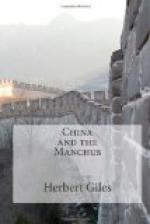In addition to his military campaigns, K`ang Hsi carried out several journeys of considerable length, and managed to see something of the empire beyond the walls of Peking. He climbed the famous mountain, T`ai-shan, in Shantung, the summit of which had been reached in 219 B.C. by the famous First Emperor, burner of the books and part builder of the Great Wall, and where a century later another Emperor had instituted the mysterious worship of Heaven and Earth. The ascent of T`ai-shan had been previously accomplished by only six Emperors in all, the last of whom went up in the year 1008; since K`ang Hsi no further Imperial attempts have been made, so that his will close the list in connexion with the Manchu dynasty. It was on this occasion too that he visited the tomb of Confucius, also in Shantung.
The vagaries of the Yellow River, named “China’s Sorrow” by a later Emperor, were always a source of great anxiety to K`ang Hsi; so much so that he paid a personal visit to the scene, and went carefully into the various plans for keeping the waters to a given course. Besides causing frequently recurring floods, with immense loss of life and property, this river has a way of changing unexpectedly its bed; so lately as 1856, it turned off at right angles near the city of K`ai-feng, in Honan, and instead of emptying itself into the Yellow Sea about latitude 34º, found a new outlet in the Gulf of Peichili, latitude 38º.
K`ang Hsi several times visited Hangchow, returning to Tientsin by the Grand Canal, a distance of six hundred and ninety miles. This canal, it will be remembered, was designed and executed under Kublai Khan in the thirteenth century, and helped to form an almost unbroken line of water communication between Peking and Canton. At Hangchow, during one visit, he held an examination of all the (so-called) B.A.’s and M.A.’s, especially to test their poetical skill; and he also did the same at Soochow and Nanking, taking the opportunity, while at Nanking, to visit the mausoleum of the founder of the Ming dynasty, who lies buried near by, and whose descendants had been displaced by the Manchus. Happily for K`ang Hsi’s complacency, the book of fate is hidden from Emperors, as well as from subjects,—
All but the page prescribed, their present state and he was unable to foresee another visit paid to that mausoleum two hundred and seven years later, under very different conditions, to which we shall come in due course.
The census has always been an important institution in China. Without going back so far as the legendary golden age, the statistics of which have been invented by enthusiasts, we may accept unhesitatingly such records as we find subsequent to the Christian era, on the understanding that these returns are merely approximate. They could hardly be otherwise, inasmuch as the Chinese count families and not heads, roughly allowing five souls to each household. This plan yields a total of rather over fifty millions for the year A.D. 156, and one hundred and five millions for the fortieth year of the reign of K`ang Hsi, 1701.




